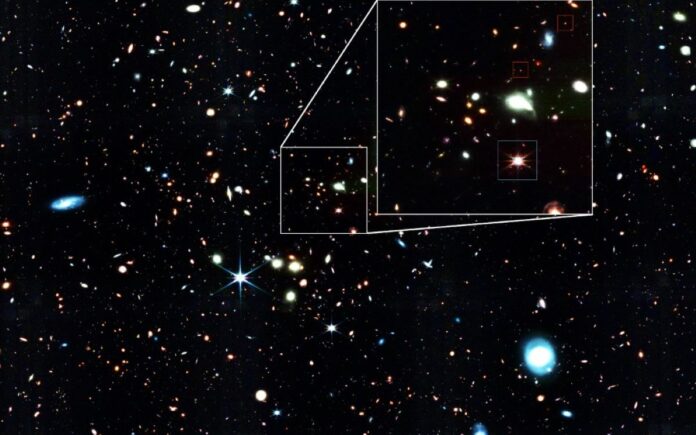Understanding the creation of supermassive black holes (SMBHs) and their role in cosmic reionization depends on characterizing the prevalence and features of weak active galactic nuclei (AGNs) in the early Universe.
JWST recently spotted a bunch of tiny red dots in the distant Universe. The discovery could change how we understand supermassive black holes’ genesis. It could also take scientists a step closer to answering one of the most significant dilemmas in astronomy: According to the current models, some supermassive black holes in the early Universe have grown ‘too fast.’ Then how did they form?
Through the ‘eyes’ of the older Hubble Space Telescope, these tiny red dots were indistinguishable from normal galaxies.
Jorryt Matthee, Assistant Professor at the Institute of Science and Technology Austria (ISTA) and lead author of the study, said, “Without having been developed for this specific purpose, the JWST helped us determine that faint little red dots–found very far away in the Universe’s distant past–are small versions of extremely massive black holes. These special objects could change how we think about black holes’ genesis.”
According to Albert Einstein’s general theory of relativity, black holes might have any mass, published more than a century ago. Supermassive black holes (SMBHs), which have masses that could be millions or billions of times that of the Sun, are among the most fascinating black holes. Most massive galaxies have an SMBH at their core, according to astrophysicists. The evidence is that Sagittarius A* in the center of our galaxy is an SMBH with a mass greater than four million times that of the Sun, and it won the 2020 Nobel Prize in Physics.
Still, there are differences among SMBHs. Some SMBHs proliferate through the absorption of massive amounts of matter. As a result, they get so bright that they may be seen to the edge of the Universe that never stops growing. These supermassive black holes, or quasars, are some of the Universe’s brightest objects.
However, some quasars are so massive—too massive given the age of the Universe at which they are observed—that they are known as problematic quasars.
Matthee said, “If we consider that quasars originate from the explosions of massive stars–and that we know their maximum growth rate from the general laws of physics, some of them look like they have grown faster than is possible. It’s like looking at a five-year-old child that is two meters tall. Something doesn’t add up. Could SMBHs perhaps grow even faster than we originally thought? Or do they form differently?”
Scientists have identified a population of objects that appear as little red dots in JWST images. They also demonstrated that these objects are SMBHs but not overly massive ones.
Identifying Hα spectrum emission lines with broad line profiles was crucial for proving that these objects are supermassive black holes. Heat-induced spectral lines, known as Hα lines, appear in the deep-red portion of the visible light spectrum. The width of the spectra traced the velocity of the gas.
Matthee said, “The wider the base of the Hα lines, the higher the gas velocity. Thus, these spectra tell us that we are looking at a tiny gas cloud that rushes and orbits something very massive like an SMBH.”
“However, the little red dots are not the giant cosmic monsters found in overly massive SMBHs.”
“While the ‘problematic quasars’ are blue, extremely bright, and reach billions of times the mass of the Sun, the little red dots are more like ‘baby quasars.’ Their masses lie between ten and a hundred million solar masses. Also, they appear red because they are dusty. The dust obscures the black holes and reddens the colors.”
However, these tiny red specks will eventually become giants when the black hole gas outflow breaks through the dust cocoon. According to the ISTA astronomer and his colleagues, the little red spots are tiny red copies of massive blue SMBHs in the phase before the problematic quasars.
For this study, the team used the datasets acquired by the EIGER and FRESCO collaborations.
Matthee said, “EIGER was designed to study specifically the rare blue supermassive quasars and their environments. It was not designed to find the little red dots. But we found them by chance in the same dataset. This is because, using the JWST’s Near Infrared Camera, EIGER acquires emission spectra of all objects in the Universe.”
“If you raise your index finger and extend your arm completely, the region of the night sky we explored corresponds to roughly a twentieth of the surface of your nail. So far, we have probably only scratched the surface.”
Journal Reference:
- Jorryt Matthee, Rohan Naidu et al. Little Red Dots: An Abundant Population of Faint Active Galactic Nuclei at z ∼ 5 Revealed by the EIGER and FRESCO JWST Surveys. The Astrophysical Journal. DOI 10.3847/1538-4357/ad2345
